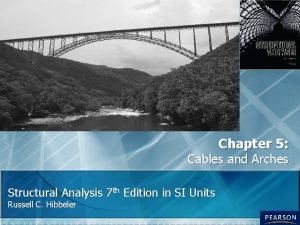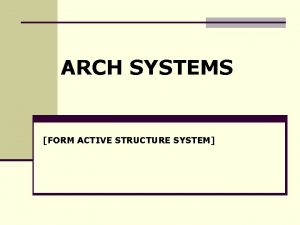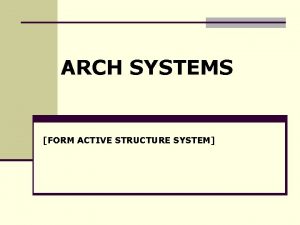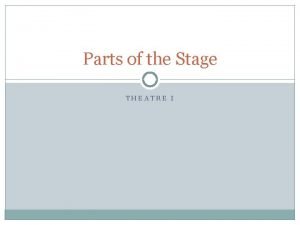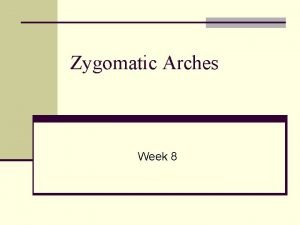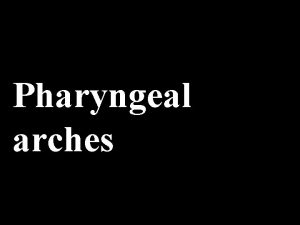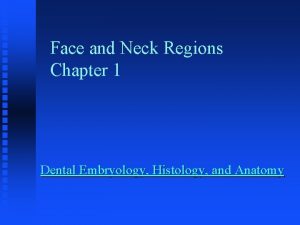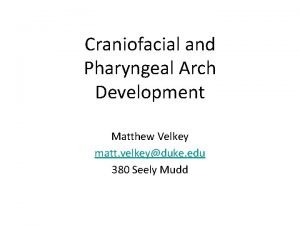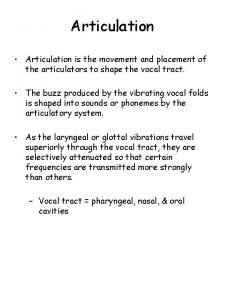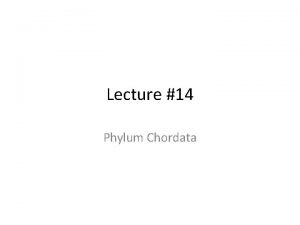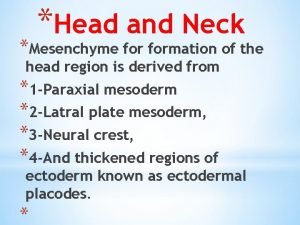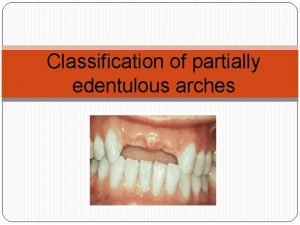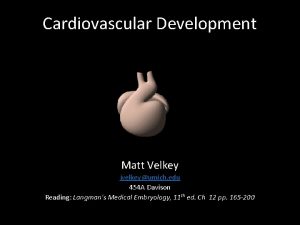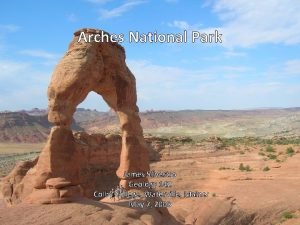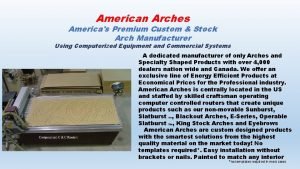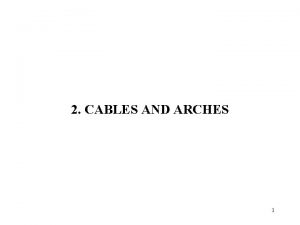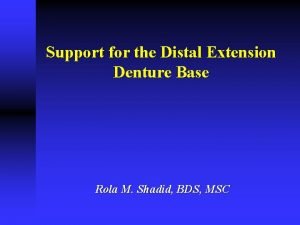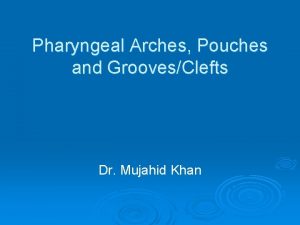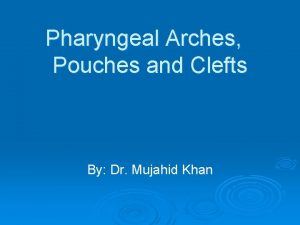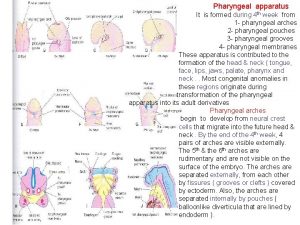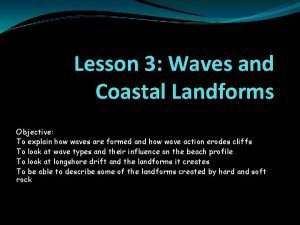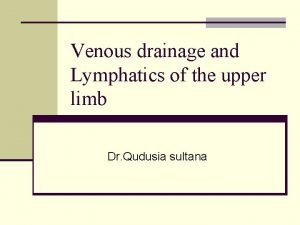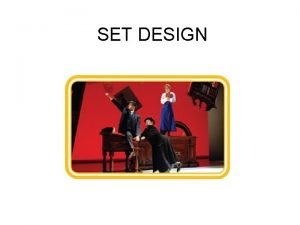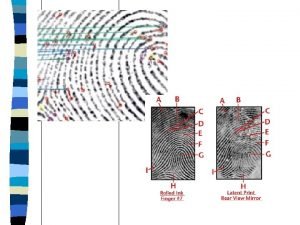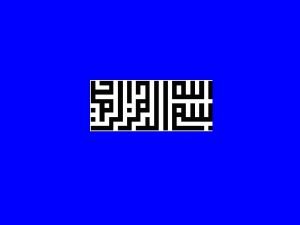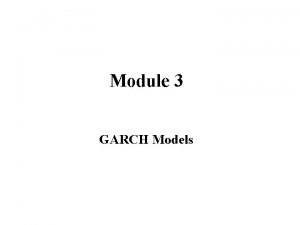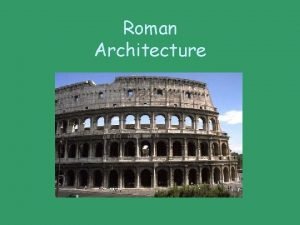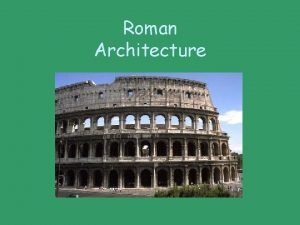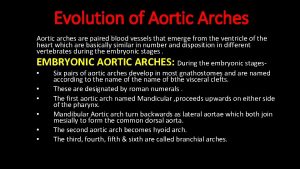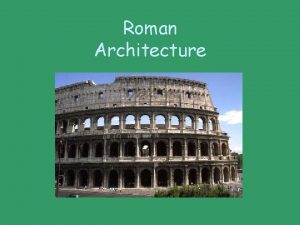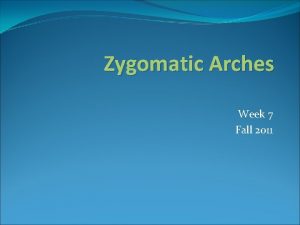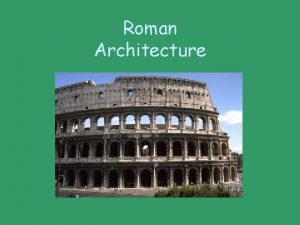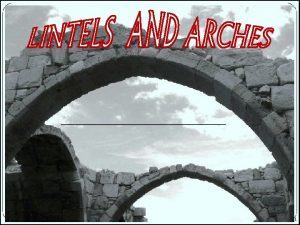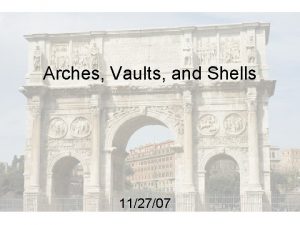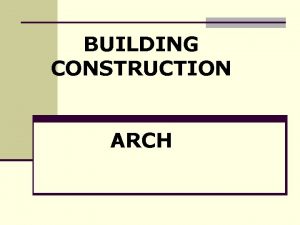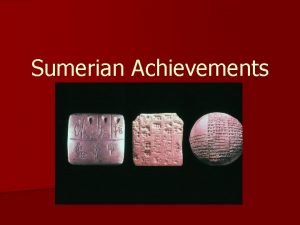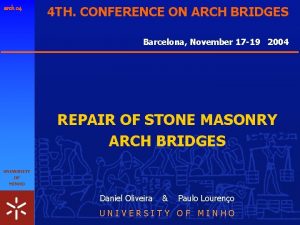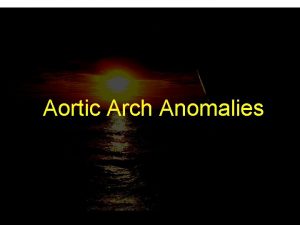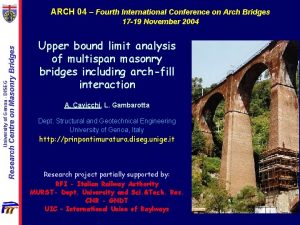ARCHES DEFINITION An arch is a structure which










































- Slides: 42

ARCHES


DEFINITION “An arch is a structure which is constructed to span across an opening”. ØGenerally all the openings in any structure are either provided with an Arch or Lintels. ØThey are designed in such a way that, they carry the loads of the portion of the wall above the openings. ØThis load is then transferred to the walls through the ends placed on the masonry.

Characteristics of an Arch ØArches are generally constructed with the small wedge -shaped(Dressed) units. ØThey are joined with the help of mortar. ØArches made of Steel and RCC are built in single units. ØHere no wedge-shaped units are used. ØThis type of arches are used in construction of Bridge.



Technical terms Intrados: This is the inner curve of an arch. Soffit: This is the inner surface of the arch. Sometimes the term, Intrados and Soffit are treated as Synonymous. Extrados or Back: This is external curve of an arch. Voussoirs: These are the wedge-shaped units forming the course of an arch.

Skewback: This is the inclined surface on the Abutment. It is prepared to receive the arch and form it(complete). Springer: This is the first Voussoir at springing level on the either side of an arch and it is immediately adjacent to the skewback. Crown: This is the highest point of the extrados. Key: This is the wedge shaped unit at the crown of an arch. It is sometimes projected above & below outlines of an arch

Piers: These are the intermediate supports of an arcade. Springing points: These are the points from which the curve of an arch springs. Springing line: This is the imaginary horizontal line joining two springing points. Span: This is the clear horizontal distance between the supports.

Rise: This is the clear vertical distance between the highest point on the intrados and springing line. Centre: This is the Geometrical centre of the curve of an arch. Ring: This is circular course forming an arch. Depth or Height: This is the perpendicular distance between intrados and extrados.

Spandril: This is the irregular triangular space formed between the extrados & horizontal line drawn tangent to the crown. Haunch: This is the lower half portion of the arch between crown and skewback. Arcade: this is a row of arches supporting a wall above and being supported by the piers.


Crushing Of The Masonry: ØIf the compressive stress exceeds the safe crushing strength of the masonry unit and mortar , the arch will fail in crushing. Measures to be taken to avoid failure of arch due to crushing: ØThe material should be of adequate strength. Ø Size of Voussoirs should be properly designed. Ø They should be properly designed to bear the thrust transmitted through them. ØIf necessary Voussoirs of different height are used.

Sliding Of Voussoirs: • All bed joints should be perpendicular to the line of the least resistance, normally they are made normal to the curve of arch, where they are nearly perpendicular to the line of least resistance. • Depth of the voussoirs should be adequate to resist the tendency of joints to open and slide upon one after other. Rotation Of Some Joint About An Edge: To prevent the rotation of joint, ØRotation can be prevented , if the line of resistance is kept within intrados and extrados. ØAlso, the thrust should be made to cross the joint away from the edge to prevent the crushing of that edge.

Uneven Settlement Of An Abutment Or Pier: ØUneven settlement of abutment causes the failure of an arch. ØHence, the abutment which has ultimately to bear all the load transferred to the arch , should be strong enough. ØAlso, the arch should be symmetrical , so that unequal settlements of the two abutment is minimized.

Types of arches 1) Classified according to shape 2) Classified according to the number of centres 3) Classified according to workmanship 4) Classified according to the materials construction. of

Classification according to shape •

Segmental Arch: ØThe centre of the arch is situated below the springing line. ØThis is common type of arch used for buildings. ØSegmental in shape and provided over the openings. ØProvided over lintel. ØGenerally, used for construction of Bridges.

• Semi Circular Arch: ØThe centre of the arch lies on the springing line. ØThe shape of the curve of the arch is a Semi-Circle. ØHere Skew-back is horizontal. ØHence load transferred to the abutment is perfectly in vertical direction.

Relieving Arch: ØThis type of arch is constructed over a wooden joist or a flat arch. ØIt relieves the joist or flat arch from carrying the loads. ØThe span of the this arch will be clear span of opening + twice the bearing of wooden joist. ØThis type of arch helps in replacing decayed or damaged wooden lintel without disturbing the stability of the structure.


Dutch or French Arch § Similar to the flat arch in design, but differs in shape and method of construction. § Suitable for small opening • A flat arch in brick; most of the bricks slope outward from the middle of the arch • maintain same angle on both sides of the centerline

Horse-Shoe Arch: • This arch has a shape of horse shoe. incorporating more than a semicircle. It is mainly adopted from architectural considerations. Famous in moorish architecture.

Classification according to the number of centres One-Centered arch: ØThis type of arch has only one centre. ØFlat, segmental, semi-circular, horseshoe are one centered arches.

Two-Centered Arch: ØThis type of arch has two centres. ØPointed arch is an example for two-centered arches.

Three-Centered Arch: ØThis type of arch has 3 centres. ØSemi-ellipse arch is an example for 3 centered arch.

Four-Centered Arch/Tudor Arch: ØThis type of arch has 4 centres. ØVenetian arch is an example for 4 centered arch.

Five-Centered Arch: ØThis type of arch has 5 centres. ØIt nearly look like a semielliptical arch.

Classification according to workmanship Rough Arch: ØThese arches are built with ordinary bricks, which are not in wedge shape. ØAlso known as “RELIEVING ARCHES”. ØMade up of rectangular brick that are not cut into wedge shape. ØCurvature are obtained by mortar. ØRough arches are used where appearance is of secondary importance.


Axed or Rough-Cut arches: ØBricks are cut to wedge-shape. ØAccording to class of work bricks are rough-axed or fine-axed. ØThe thickness of mortar joints vary from 3 -6 mm. ØJoints of arches are of uniform thickness. ØNot dress finely so it does not give much attractive appearance.


Gauged arch: ØAccurately prepared to wedge shaped units are used. ØMortar joints are as thin as 0. 75 mm-1. 5 mm. ØSpecially shaped bricks known as “RUBBER BRICKS” are used. ØIn this type arch, bricks are cut to exact shape and size of required voussoir with the help of wire saw. The bricks are finely dressed and these bricks are joined by lime putty. But, for gauged brick arches only soft bricks are used


Classified according to the materials of construction Stone Arches: ØThey can be constructed in Rubble or Ashlar Masonry. ØRubble Masonry arch is comparatively weak. Hence used for inferior works. ØIn construction of RMA stones are not finely dressed. ØSpan if Rubble Masonry stone arch is limited to 1 m. ØAshlar Masonry arch is constructed with wedge shaped units. ØSegmental arch is an example.


Brick Arches: ØThese arches are constructed with ordinary or purpose made bricks. ØSince ordinary bricks are not cut into shape, rough arches are formed. ØArch is obtained with the help of mortar. ØRough bricks arches are not suitable for exposed brickwork. ØPurpose-made bricks are special bricks of different size and shapes which are suitable for arch work. ØThey are used for good quality work.



Concrete Arches: ØThese arches are constructed of Pre-Cast Cement Concrete Blocks or Monolithic Concrete. ØConcrete blocks are prepared in moulds. ØMonolithic concrete arches are constructed from Cast-in. Situ. ØThey are suitable for bigger spans. ØHence they are employed in construction of culverts and bridges.


Stability of an arch ØAn arch transmits super-imposed load to the abutments or piers or side walls through the combined action of forces between the surfaces of Voussoirs. ØEvery element of an arch remain in compression. An arches fail due to: 1)Crushing of the masonry. 2)Sliding of Voussoirs. 3)Rotation of some joints about an edge. 4)Uneven settlement of an abutment or pier.
 Structural analysis
Structural analysis Form active structure example
Form active structure example Which features of the sun look like huge cloud-like arches?
Which features of the sun look like huge cloud-like arches? Active structure
Active structure Apron theatre definition
Apron theatre definition Zygomatic arch view positioning
Zygomatic arch view positioning Post trematic
Post trematic Kennedy class 4 mod 2
Kennedy class 4 mod 2 Facial region
Facial region Structures derived from pharyngeal arches
Structures derived from pharyngeal arches Pharyngeal arches
Pharyngeal arches Anterior posterior pillars
Anterior posterior pillars Arches national park cua
Arches national park cua Nba expansion st louis
Nba expansion st louis Urochordata
Urochordata Gill arches
Gill arches Tuberculum impar
Tuberculum impar Peronues longus
Peronues longus Class 3 kennedy classification
Class 3 kennedy classification Septum primum
Septum primum James silvestro
James silvestro American arches
American arches Cables and arches
Cables and arches Rain washing away soil from a hillside
Rain washing away soil from a hillside Support for distal extension rpd
Support for distal extension rpd Pharyngeal arches
Pharyngeal arches Third pharyngeal arch
Third pharyngeal arch Pharyngeal arches
Pharyngeal arches Bad arches
Bad arches Peroneus tertius muscle
Peroneus tertius muscle Hypobranchial eminence
Hypobranchial eminence Bays and headlands
Bays and headlands Arch hillingdon
Arch hillingdon Supratrochlear lymph node
Supratrochlear lymph node Scapula lymph nodes
Scapula lymph nodes Profunda brachii artery
Profunda brachii artery Transpalatal arch space maintainer indications
Transpalatal arch space maintainer indications In the round stage drawing
In the round stage drawing Fingerprint short ridge
Fingerprint short ridge Arch feedback model
Arch feedback model Band and loop cementation
Band and loop cementation Oropharynx laryngopharynx nasopharynx
Oropharynx laryngopharynx nasopharynx Arch model
Arch model
